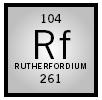Rutherfordium

MELTING POINT:
Unknown
BOILING POINT:
Unknown
DENSITY:
Unknown
MOST COMMON IONS:
Unknown
Rutherfordium is the first transactinide element. It was discovered in 1969 by Albert Ghiorso and his coworkers, who carried out the reactions 249 Cf ( 12 C, 4n)→ 257 Rf (half-life of approximately 3.8 seconds) and 249 Cf( 13 C, 3n) [→] 259 Rf (half-life of approximately 3.4 seconds). There are ten known isotopes of rutherfordium, having mass numbers that range from 253 to 262, the isotope with the longest measured half-life being 261 Rf (half-life of approximately 1.1 minutes). After its discovery, it was postulated that rutherfordium, as the first transactinide element, should be a member of a new, fourth transition series, extending from Z = 104 to Z = 112, and an atom in which the 6 d electronic shell is filled. The outer orbital electronic configuration of Rf should be [Rn]5 f 14 6 d 2 7 s 2 . As such, it should behave similarly to its analogs titanium and hafnium and should form volatile tetrachlorides that are less volatile than HfCl 4 . The first gas chromatographic studies showed that rutherfordium forms more volatile chlorides than hafnium—a deviation from Periodic Table trends that was predicted from relativistic calculations . The first aqueous chemistry studies showed the neutral and anionic complexes of Rf to behave like the corresponding complexes of the Group IVB elements, rather than of the trivalent actinides, demonstrating that Rf is indeed a transactinide. Detailed studies of the extraction chromatography of Rf complexes have shown chemical behavior similar to that observed of Rf complexes in gas chromatographic experiments—that is, Rf does not behave as expected according to a simple extrapolation of Periodic Table trends, but in a more complicated manner. For example, in the extraction of substances with tributylphosphate, the extraction sequence Zr > Rf > Hf is observed. These and other experiments show that the aqueous chemistry of rutherfordium is a challenge to current relativistic molecular theories.
SEE ALSO Actinium ; Berkelium ; Einsteinium ; Fermium ; Lawrencium ; Mendelevium ; Neptunium ; Nobelium ; Plutonium ; Protactinium ; Thorium ; Uranium .
Walter Loveland
Bibliography
Seaborg, Glenn T., and Loveland, Walter D. (1990). The Elements beyond Uranium. New York: Wiley.
Comment about this article, ask questions, or add new information about this topic: